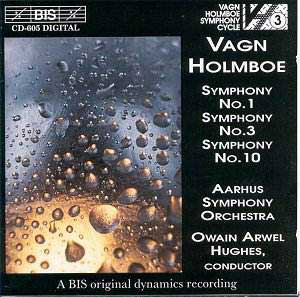This fascinating trio of symphonies takes Holmboe from his
Rumanian study trips and marriage to Meta May Graf through the first of
his wartime symphonies to the stunning Tenth, a period of some thirty-five
years. Holmboe had studied with a variety of composition teachers – Toch,
briefly, in Berlin and Honegger later in Paris amongst them and it was
shortly after his return to Denmark that he began work on the First Symphony,
written for a chamber orchestra and his Op 4. This three-movement work
– in conventional fast-slow-fast format - was composed between June and
September 1935 but was to be performed only in 1938 in a performance given
by the Aarhus City Orchestra conducted by Thomas Jensen.
Opening with a supportive drum tattoo and incipiently
event-laden orchestration it is vaguely neo-classical in profile. Slashing
attacks and a staunch motto-repeating trumpet begin counter waves of
material, elegant and decorative flute, a return to the initial propulsive
theme and renewed thrusting, eventually blazing conclusiveness. The
slow movement is pastoral with interjectory incident, a strong rhythmic
impetus underlying all and Holmboe displays his ability, even this early
in his compositional career, to conjoin material initially seemingly
disparate. The finale picks up the vigour of the opening movement and
is launched by wood blocks; the trumpet is again prominent in the ensemble
adding direction and incisiveness to the movement, replenishing and
redoubling its material in concise attacks. This sixteen-minute symphony,
vibrant, energetic and attractive opens the Holmboe canon with uncomplicated
surety and great orchestral confidence.
The Third has the sub-title Sinfonia rustica
and dates from 1941, the first of his three wartime symphonies. Like
the first it opens in a spirit of confidence employing Jutish melodies
energised and augmented by a powerfully determined and astringent trumpet,
a recurring Holmboe device, and an orchestral tool not unknown to his
one–time composition teacher, Honegger. The second movement, a series
of variations, is melancholy with powerful tread, inexorable and sustained.
It gains in amplitude and volume rising to a restrained and profoundly
moving nobility of utterance until the appearance of the brass, strident
and implacable and the renewed string tread. One of the greatest symphonic
statements of the wartime years ends with a note of determined ambiguity.
By contrast the finale is all lightness and mobility with an ebullient
series of dance episodes, vivacious and captivating, driving with folkloric
vigour to a festive close.
The distance between the Third and Tenth symphonies
is not one measured in years alone. The Tenth was composed in 1970-71
and premiered by the Detroit Symphony orchestra under Sixten Ehrling.
It opens with percussion and much glowering reserve. Percussive interjection
provokes more dark hued orchestral material – oily black lower brass,
suspended woodwind figures, static strings – until more martial drums
lend an urgency and cumulative power which both relaxes and onrushes.
Scurrying material frantically propels the metamorphisised argument
onward. As the movement began with anticipatory cymbal so it ends with
abrupt drums – an arc of delineated tension and powerfully argued material,
concise, logical, tonal, developing inexorably from the initial seed
material. The slow movement opens with solemnity, develops into some
vexed and raucous argument before turning vengeful and malign for all
the marking of andante affettuoso. For over nine minutes, as Holmboe’s
trumpet snakes through the fabric of the score, as the momentum develops
inexorably into heavy rhythmic attacks, the cumulative significance
of his material only becomes clear at the close when, remarkably, astonishingly,
the implacable rhythmic tread seems to continue beyond the movement’s
end, as if the material exists outside the constraints of symphonic
form, even beyond the constraints of time and place. The mood of grim
insistence is carried over to the finale – marked Allegro con forza
– before a gradual lightening of tone and orchestral weight leads to
occasional, though not overwhelming, outbursts. The movement concludes
with a sense of – not untroubled, still brooding – finality. As a symphonic
statement the Tenth is a deeply powerful work. Together this trilogy
of Holmboe’s symphonies establishes his place in the great hierarchy
of symphonic composers. These are superbly cogent works performed with
stunning intelligence, tonal blend, sectional discipline and conductorly
flair. Unreservedly recommended – I’m tempted to say mandatory.
Jonathan Woolf


